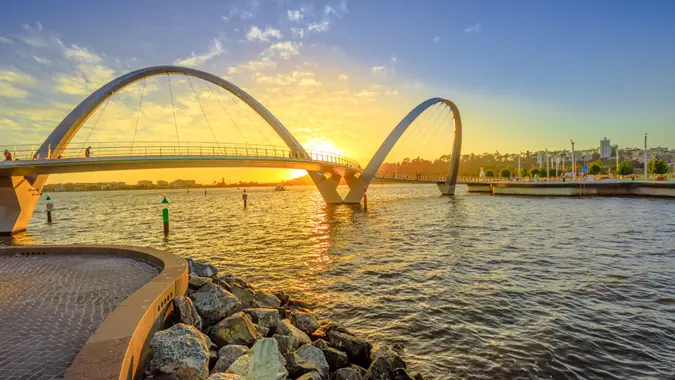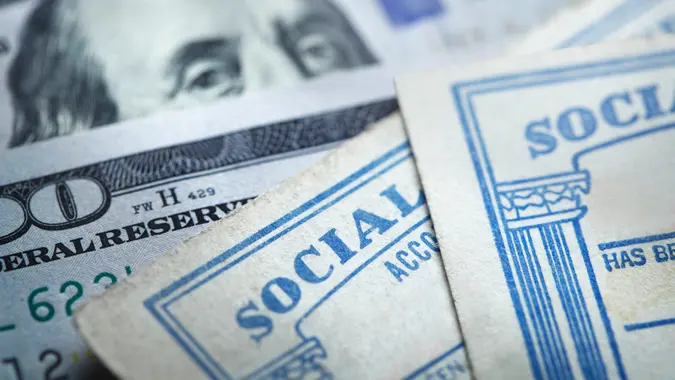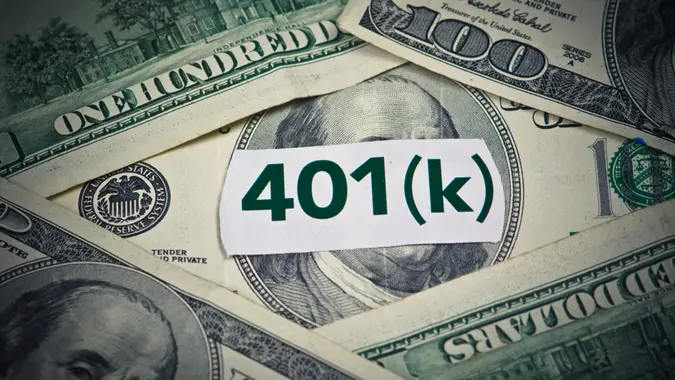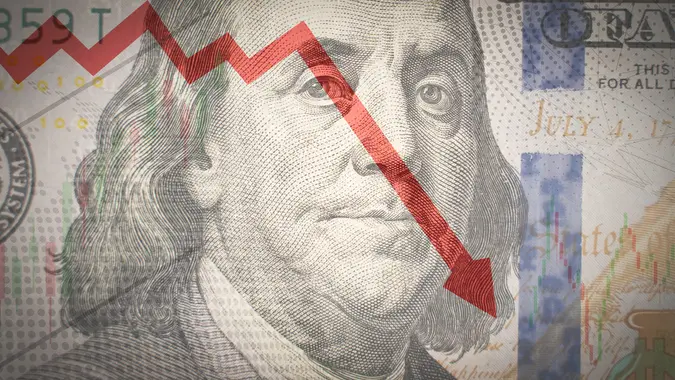Advertiser Disclosure
GOBankingRates works with many financial advertisers to showcase their products and services to our audiences. These brands compensate us to advertise their products in ads across our site. This compensation may impact how and where products appear on this site. We are not a comparison-tool and these offers do not represent all available deposit, investment, loan or credit products.
3 Best Affordable Places To Retire in Australia
 Written by
Angela Mae
Written by
Angela Mae
 Edited by
Jenna Klaverweiden
Edited by
Jenna Klaverweiden

Commitment to Our Readers
GOBankingRates' editorial team is committed to bringing you unbiased reviews and information. We use data-driven methodologies to evaluate financial products and services - our reviews and ratings are not influenced by advertisers. You can read more about our editorial guidelines and our products and services review methodology.

20 YearsHelping You Live Richer

Reviewed by Experts

Trusted by Millions of Readers
Retiring in Australia is a dream come true for many retirees. It offers a high standard of living, top-notch healthcare facilities and amenities for retirees to enjoy. It’s also got some stunning landscapes — from its many beaches to the rural outback. Plus, it has a fairly diverse climate, though even the coldest regions are still temperate at worst.
Many parts of Australia are also affordable, especially when compared with the cost of living in the United States. According to Unbiased, the average retiree spends between $60,000 and $70,000 a year there. Apartment rentals go for an average of $1,550 in major cities — cheaper than the U.S. average of $1,713 — and home prices are fairly on par.
Given all of this, it’s not hard to see why so many people would want to spend their golden years on the Gold Coast. If you’re one of them, here are the top places to retire in Australia, according to experts.
Sunshine Coast, Queensland
- One-bedroom apartment rental price: AU$1,274 monthly
- Typical house purchase price: US$605,000
- Total estimated monthly costs for one (excluding rent): US$1,090
- Cost of living vs. New York City: 47.2% lower (including rent)
- Cost of living comparison with the rest of Australia: 22.1% cheaper
“Queensland is usually the go-to suggestion for people looking to retire in Australia, with the Sunshine Coast often the destination of choice. Considering the state offers around 300 sunny days annually, alongside top-quality healthcare facilities and transport links, making the move as you get older could be a wise decision,” said Sarah Donaldson, senior travel claims analyst at Fast Cover Travel Insurance.
Some parts of Sunshine Coast are pricier than others, so retirees have options depending on their budget.
“Communities like Noosa and Maroochydore offer an incredible coastal lifestyle, but it’s important to consider the costs,” Donaldson said. “Property is expensive, like most of Australia, with the average house on the Sunshine Coast costing over AU$900,000 (US$605,000). Fortunately, purchasing property in suburbs like Nambour and Palmview costs substantially less.”
Costs also depend on your individual needs and lifestyle goals. If you’re happy with a slightly smaller house beyond the city limits, you could save money. You’ll still need to factor in transportation and other costs, of course.
Mac Steer, owner and director of Simify, a travel SIM company, also recommended the Sunshine Coast in Queensland for its high quality of life and overall affordability.
“Cost of living is estimated to be 5% to 10% lower than Brisbane of the Gold Coast … with grocery prices, utilities and healthcare all costing less,” he said.
St. Helens, Tasmania
- One-bedroom apartment rental price: AU$1,600 monthly
- Typical house purchase price: US$335,000
- Cost of living vs. New York City: 80% lower (including rent)
“While many retirees head to the northern reaches of Australia for its warm weather, you shouldn’t overlook the south. Although it’s bound to be colder and wetter, charming towns like St. Helens in Tasmania offer peaceful serenity amid some of the world’s most striking scenery, such as the Bay of Fires,” Donaldson said.
St. Helens is a very small town with only about 2,200 residents living there. Because of that, the cost of living data is currently limited. According to Donaldson, however, costs are still fairly reasonable in St. Helens compared with other parts of the continent.
“Alongside a small population aged mostly over 50, St. Helens features excellent amenities for retirees, including a hospital, delicious restaurants and tranquil outdoor activities,” Donaldson said. “With the median house costing around AU$500,000 (US$335,000), it’s also a more affordable option for retirement compared to much of the country.”
Mornington Peninsula, Victoria
- One-bedroom apartment rental price: AU$2,224 monthly
- Typical house purchase price: AU$1 million-plus
- Total estimated monthly costs for one (excluding rent): US$1,060
- Cost of living vs. New York City: 47.1% lower (including rent)
The Mornington Peninsula is about an hour’s drive from Melbourne, which is perfect for retirees who want access to larger cities but don’t want to be inundated with the hustle and bustle of city life. According to Donaldson, the area has stunning beaches, excellent dining options, extensive cultural activities and everything else retirees need to live a comfortable lifestyle.
“For those with high budgets, blue-chip suburbs like Portsea, Blairgowrie and Sorrento feature everything needed for retirement,” she said. “However, those exploring more affordable areas should consider neighborhoods like Mornington, Safety Beach and Dromana.”
What To Know About Retiring in Australia
Now, before getting your heart set on retiring in Australia, there are a few things you should know.
On the plus side, Unbiased found that a couple of retirees can live a modest but comfortable lifestyle in Australia for about US$47,375 a year — excluding rent. Housing prices can be on the higher side with an average of US$710 per square foot of apartment space. Groceries can also be expensive.
There’s also taxes to think about. In Australia, your pension and investment earnings can be taxed. As a foreigner, you may also be subject to other taxation, so consult with a legal professional about this to make sure the move fits into your budget.
Last but certainly not least is the fact that Australia has discontinued its retirement visa and investment retirement visa. If you already had an Australian retirement visa before May 8, 2018, you could be eligible for permanent residency. Otherwise, you may have to seek an alternative route.
Unless stated otherwise, all other data come from Numbeo, My Life Elsewhere, Move to More and Realestate.com.au.
Share This Article:




You May Also Like

Here's the Salary You Need To Make To Get the Maximum Social Security Benefit
November 13, 2025
6 min Read

What It Takes To Be Upper Class in America Plus 10 Safest Retirement Towns for Upper Class
November 13, 2025
6 min Read

Dave Ramsey Urges Americans To Pause 401(k) Contributions -- Should You?
November 13, 2025
6 min Read


I Asked ChatGPT What the Smartest Retirement Moves Are for People in Their 50s
November 13, 2025
6 min Read


7 Popular Retirement Destinations That Are Overrated -- and Where To Go Instead
November 10, 2025
6 min Read

If Wealth Was Distributed Equally Across the US, How Long Would the Money Last New Retirees?
November 13, 2025
6 min Read


Smart Ways To Prepare Your Finances for Digital Social Security Payments
November 12, 2025
6 min Read

5 Things Middle-Class Retirees Can Learn From the Upper Class About Retirement
November 13, 2025
6 min Read

How Many Hours Can You Work and Still Collect Social Security Benefits?
November 13, 2025
6 min Read


- How Long Will My Money Last?
- How Much Do You Need To Retire?
- How To Prepare For Retirement
- How To Save For Retirement Without A 401K
Learn More About Early Retirement Planning
Make your money work for you
Get the latest news on investing, money, and more with our free newsletter.
By subscribing, you agree to our Terms of Use and Privacy Policy. Unsubscribe at any time.


Thanks!
You're now subscribed to our newsletter.
Check your inbox for more details.



Sending you timely financial stories that you can bank on.
Sign up for our daily newsletter for the latest financial news and trending topics.
For our full Privacy Policy, click here.
Looks like you're using an adblocker
Please disable your adblocker to enjoy the optimal web experience and access the quality content you appreciate from GOBankingRates.
- AdBlock / uBlock / Brave
- Click the ad blocker extension icon to the right of the address bar
- Disable on this site
- Refresh the page
- Firefox / Edge / DuckDuckGo
- Click on the icon to the left of the address bar
- Disable Tracking Protection
- Refresh the page
- Ghostery
- Click the blue ghost icon to the right of the address bar
- Disable Ad-Blocking, Anti-Tracking, and Never-Consent
- Refresh the page




